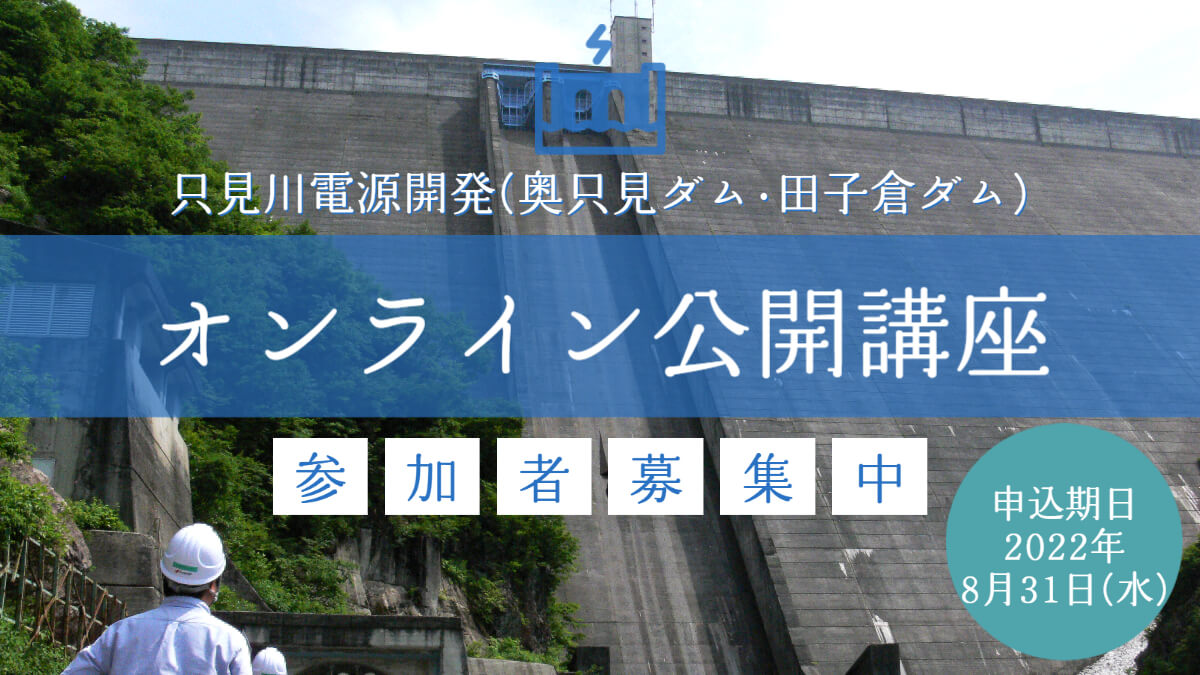An online public lecture titled "Building Giant Dams on the Tadami River" will be held on the Tadami River Power Development (Okutadami Dam and Tagokura Dam), which was investigated and covered by Professor Shuji Tanaka of Tohoku University. He will explain how they were built from various perspectives, including social background, local conditions, and civil engineering technology.
Although this is an educational course for working people due to the recurrent nature of the course, Prof. Tanaka said that it is not only for dam experts, but also for dam enthusiasts. Those who are interested should definitely attend.
The schedule includes lectures not only on Okutadami Dam and Tagokura Dam, but also on the Kosaka Mine and Sendai Lignite Coal Mine, so it seems that visitors can learn about the history of the development of technologies that are familiar to them.
the study of the history of modern technology
- Application deadline: Wednesday, August 31, 2022
Inquiries about the application are accepted from 9:00 a.m. to 4:00 p.m., excluding weekdays from 11:30 a.m. to 1:30 p.m. - How to apply: Access the application Google form (below) and fill out all required information.
- Where to apply:Public Lecture (Recurrent Education Course) Application Google Form(Google account required)
- Course Dates: Monday, September 5, 2022 - Wednesday, September 7, 2022
- Hours: 18
- Training fee: 0 yen
- Number of applicants: 100
Dates, etc. (Original text below)
Monday, September 5, 2022
8:50 a.m. - The Story of Kosaka Mine (Prof. Shuji Tanaka)
Kosaka Town, located in the northernmost part of Akita Prefecture, is home to a gorgeous Meiji-era Western-style house and a Kabuki theater with a revolving stage. Why would such a thing exist in a mountain town? The story that will help solve this mystery is the 150-year history of the Kosaka Mine. Kosaka once had the largest copper mine in the East and the second largest modern city in Akita Prefecture. The Kosaka Mine, which passed through the rough and tumble of the times, closed about 30 years ago, but it still produces gold, silver, and other metals. Why is that? When you finish listening to this grand tale of rise and fall, you will understand that Kosaka has become the source of many of Japan's leading companies.
13:00 P.M. - Urban subcutaneous memory, Sendai Lignite (Nobuaki Date, Part-time lecturer = Professor, Kyoto University of Art)
Sendai lignite, an alternative fuel source to coal, was procured from nearby mountains and supported people's daily lives, especially during the period of scarcity after World War II. This exhibition introduces the process of research that began in 2012 with no prior knowledge of the area and the "subcutaneous memory of the city" that continues to flicker and gradually fade into the distance.
Tuesday, September 6
8:50 a.m. - History of Recording Technology (Prof. Kentaro Tozu)
Dr. Tozu of the Center will give a lecture on the history of recording technology, especially in relation to the historical instruments displayed in the "History of Modern Technology Exhibition Room" at the Microsystem Integration Research and Development Center (located in the Junichi Nishizawa Memorial Research Center). He will also explain how the principles of these historical devices are being utilized as current technology.
Afternoon 13:00- Technical History of Integrated Circuits (Takashi Yunoue, Part-time Lecturer = Semiconductor Critic/Journalist)
Mr. Yunoue, who is active as a semiconductor critic, will give a lecture on the technological history of semiconductor integrated circuits. In particular, he will explain in detail how and why Japan's semiconductor industry, once the world's number one, fell on hard times from multiple perspectives, including technology, management, and strategy, based on his own experience as a semiconductor engineer. The seminar will also provide participants with material to consider what should be done for the Japanese industry in the future. Topics to be covered this year include the global semiconductor shortage, developments regarding the TSMC Kumamoto plant that the Japanese government has attracted, the impact of Russia's invasion of Ukraine on the semiconductor industry, and the impact of the 3M Belgium plant's suspension of production of the refrigerant fluorinert for dry etching.
Wednesday, September 7
8:50 a.m. - Build a huge dam on the Tadami River (Prof. Shuji Tanaka)
In the postwar period, amidst the cry of electricity shortage, plans were made to build huge dams on the upper reaches of the Tadami River - Okutadami Dam and Tagokura Dam, and the reasons why and how these huge dams were built will be explained from various perspectives, including social background, regional conditions, and civil engineering techniques. The novels "Sinking Waterfall", "Koganegyo", "Unmarked Monument", and "Whiteout", which are based on and set in the Okutadami and Tagokura dams, will also be introduced, comparing how the two dams and their construction are depicted with the actual situation. With them, we will approach the lights and shadows of the huge project that became a symbol of postwar reconstruction of the Tohoku region in the 1950s, and also let visitors feel the hardships and passion of the engineers and construction workers who faced various difficulties.
Afternoon 13:00- Technical History of Ultrasonic and Piezoelectric Devices (Michio Kadota, Senior Research Fellow)
Ultrasonic and piezoelectric devices are widely used as frequency-selective filters in cell phones and smartphones. This technology is closely related to TUAT, and it can be said that today's mobile information communications would not be possible without TUAT's technology. Dr. Kadota, after completing his master's program at TUAT (and later receiving a doctoral degree through the doctoral dissertation program), established the technology of elastic wave filters at Murata Manufacturing Company and played a leading role in making Murata's market share the largest in the world. This lecture will provide a good example of what it means to do great work as an engineer and researcher.
contact information (for inquiries) (e.g. corporate phone number)
Graduate School of Engineering, Tohoku University
TEL:022-795-5820 FAX:022-795-5824
E-mail: eng-koukai◎grp.tohoku.ac.jp (replace ◎ with @)




Comment